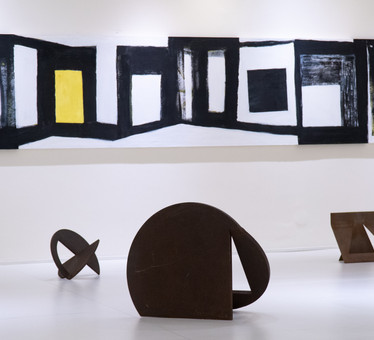Amilcar de Castro - 100 anos

São Paulo, Brasil
01/07/2020 - 14/12/2020
Since the early 1990s Brazilian artists who were part of the Neoconcrete Group have caught the eye of international museums. Up to now, the interest of American and European institutions on the production of artists who were part of the Neoconcretism have been directed towards one artist at time with large solo exhibits of Hélio Oiticica, Lygia Clark and Lygia Pape. In this context of international valuation of Brazilian art, the celebration of Almicar de Castro’s 100th birthday is the perfect moment for an in depth study on the sculptor who transformed the dimensional plane into space.
There’s an aspect about the production of this artist from Minas Gerais that corroborates the importance of the Neoconcretism – and of Amilcar de Castro’s body of work – to western art history: since the Renaissance the three-dimensional space has been mathematically flattened to the painting´s dimensional plane. The predominance of space representation through the technique of linear perspective and the impact of this symbolic form in culture stemmed the relation between world and subject at the same – vanishing?- point. We perceive space as it has been presented to us in the last 600 years: through two-dimensional representations. It is in this sense that Amilcar de Castro gives us back the world: starting from the dimensional plane, he sticks a three-dimensional structure on the floor that opens slits to other dimensions regarding our experience with the surrounding space.
Thus, not only Amilcar de Castro is a central figure in the “stand taken at non figurative geometric art (…) and specially taken at concrete art elevated at a dangerous rationalist exacerbation” as claimed on the first lines of the Neoconcrete Manifest, but he is also an artist who inverts the directions on the dimensional impoverishment of our relation to what is real. What could be a mere support, an iron board closing the multi-dimensional experience with the “real”, it is cut and folded in a way that it becomes a passage, an expansion tunnel leading to other dimensions.
Time, this dimension that is beyond three-dimensionality, presents itself to those who interact with an Almir de Castro´s sculpture in the light that cuts through the slots and in the lighting change caused by the fold. Light also changes as we move around the sculpture, as we become aware of the encounter of work of art, space and time. In the movement of our bodies we verify the effective simplicity of two gestures; cutting and folding – that reveals to us a multi-dimensional and undivided world. If we look for a weld between parts it won´t be found. As in the proposal by Merleu-Ponty, which was Ferreira Gullar´s inspiration to write the Neoconcrete Manifest, an Almir de Castro´s sculpture is totality and as so it incites total perception: listening to the world through the cut´s point of view, caressing the fold´s texture with our eyes.
Such sensorial totality imposes itself in the relation of the observer with Almir de Castro´s paintings. Hearing is part of the observing experience of paintings composed by simple and straightforward gestures. There is no brushing, there is a sweeping; lines seem to be drawn by the clashing sounds of the brush with the canvas. The resulting forms do not discard angles but defy the mathematical rationale in spiraled repetitions from the edges to the center. They are paintings that allow stains, chaos, and the gesture that reveals the other side of what is real. A gesture avoided by the mathematics of space for so many centuries thus lifting the bulkheads of painting to the level of representation of an appearance of the world.
In this sense, the glass sculptures are like prisms that supply us with a hint on the fact that our perception of what is real depends on the bulkheads that either separate or integrate us to them and on the refraction that these bulkheads´ transparencies produce as mediation. In this sheer works, Almicar de Castros´ proposal is clear: looking at one of his sculptures includes a look at the world. And the world´s look at us passing through the sculpture. We see, we are seen; we perceive and are perceived in this relation with the Neoconcrete work.
It is expected that the relevant studies that have been published in Brazil about Neoconcretism reverberate more and more on the international scene hence placing the Brazilian upturn towards Constructivism at the canon of western art history. Amilcar de Castro is fundamental for the comprehension of the Neoconcrete project´s greatness.
– Paula Braga, 2020
Dan Galeria pays tribute to the centenary of Minas Gerais artist Amilcar de Castro.
In partnership with Instituto Amilcar de Castro, A Dan Galeria is proud to celebrate the centenary of the birth of the artist who transformed the plan into space.
Amilcar de Castro - 100 Years
It is with great joy that we open the exhibition in honor of this great Brazilian artist, who transformed the plan into space: "Amilcar de Castro - 100 anos".
Amilcar de Castro 100 years - Testimony Rodrigo de Castro and Flávio Cohn
As Rodrigo de Castro - Amilcar's son - put it, an exhibition celebrating 100 years is no ordinary exhibition: "I brought here works that never left the Institute, that were never seen". Our exhibition of the centenary of Amilcar de Castro